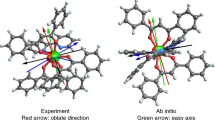Abstract
THE magnetic properties of cobalt salts have been studied theoretically by Schlapp and Penney1 under the assumption that there is one ion in the unit cell. To account for the anisotropy of the susceptibility, with three different principal values, they had to assume that the cobalt ion was acted upon by a field of predominantly cubic symmetry on which was superposed a field of lower (rhombic) symmetry, but were not able to draw any definite conclusions. The discovery by Bleaney and Ingram that in cobalt ammonium sulphate, with two ions in the unit cell, each ion has completely axial symmetry, within the experimental error, makes it possible to draw more detailed conclusions from their general theory.
This is a preview of subscription content, access via your institution
Access options
Subscribe to this journal
Receive 51 print issues and online access
$199.00 per year
only $3.90 per issue
Buy this article
- Purchase on Springer Link
- Instant access to full article PDF
Prices may be subject to local taxes which are calculated during checkout
Similar content being viewed by others
References
Schlapp, R., and Penney, W. G., Phys. Rev., 42, 666 (1932).
Author information
Authors and Affiliations
Rights and permissions
About this article
Cite this article
PRYCE, M. Hyperfine Structure of the Paremagnetic Resonance Spectrum of divalent Cobalt: Theory. Nature 164, 117–118 (1949). https://doi.org/10.1038/164117a0
Issue Date:
DOI: https://doi.org/10.1038/164117a0
Comments
By submitting a comment you agree to abide by our Terms and Community Guidelines. If you find something abusive or that does not comply with our terms or guidelines please flag it as inappropriate.



